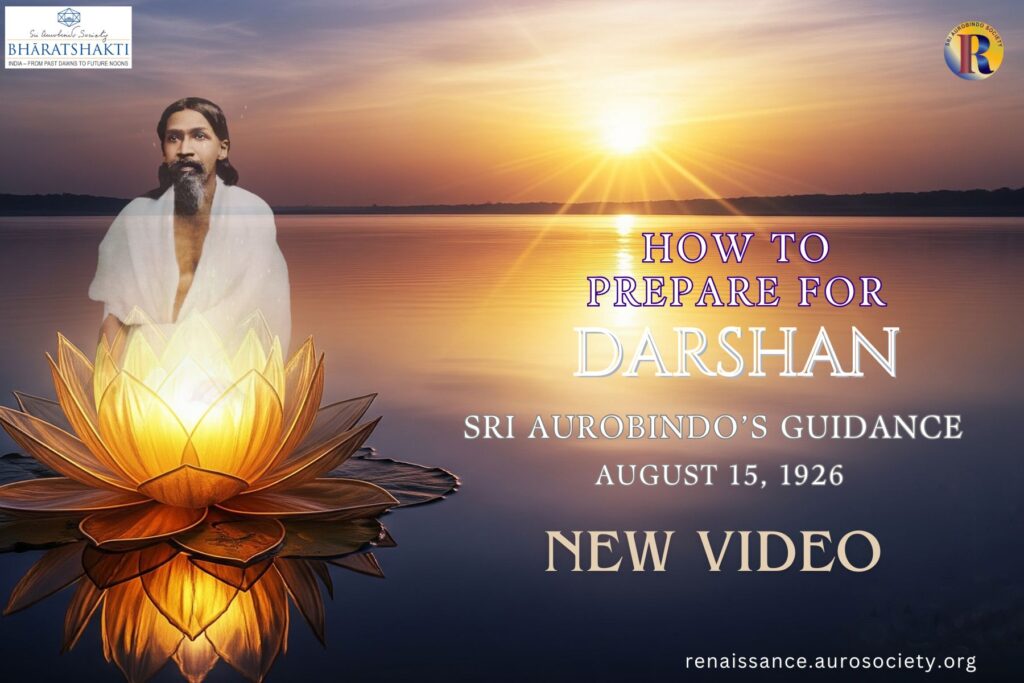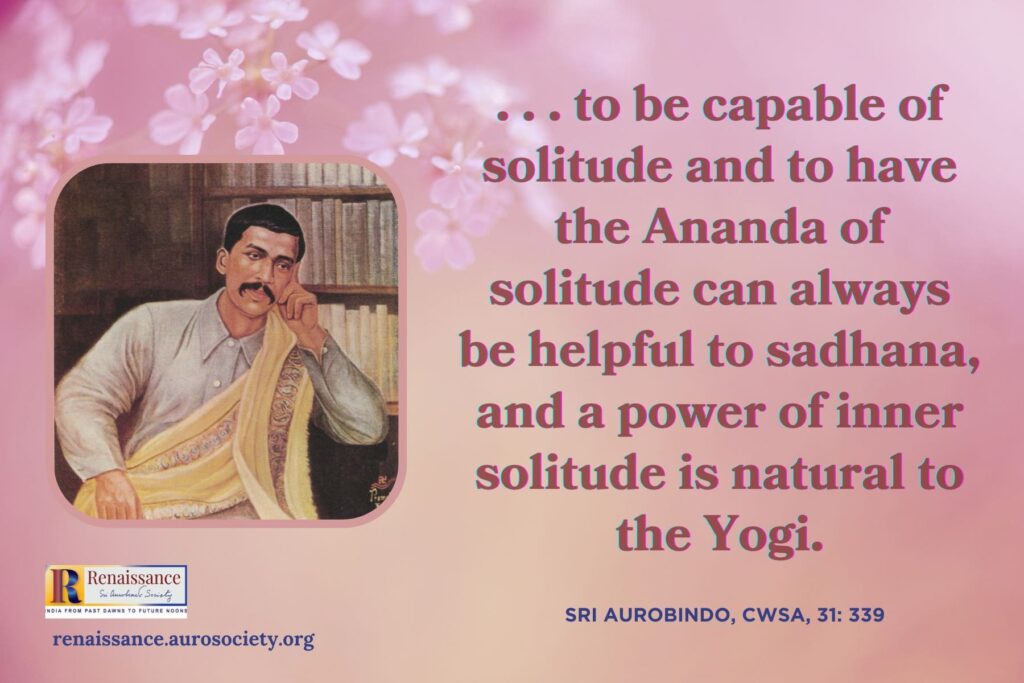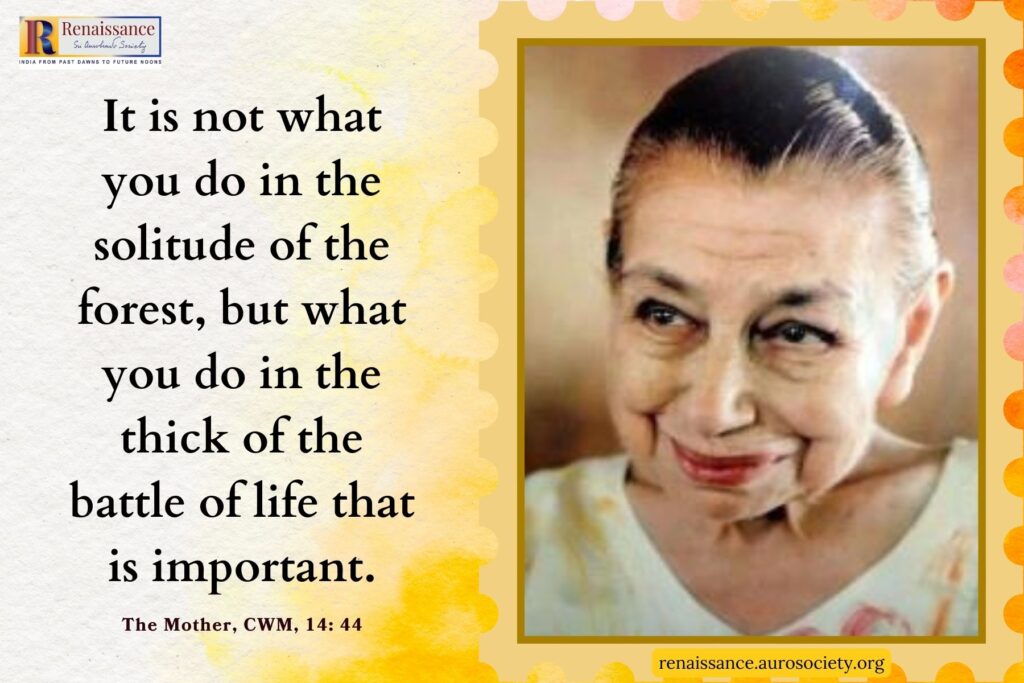Volume III, Issue 4
Author: Sri Aurobindo
Editor’s note: We often confuse or misinterpret the ‘good’ by limiting our understanding to a moral-ethical view of ‘good’ and ‘bad’, right and wrong. Sri Aurobindo wrote several letters explaining the core difference with between morality and spiritual sadhana. We feature a few of these letters. We have made a few formatting changes for this online presentation, including adding a few headings and sub-headings and shortening the paragraph length. No alteration has been made in the original text.

The Spiritual Life and the Ordinary Life
The spiritual life (adhyātma jīvana), the religious life (dharma jīvana) and the ordinary human life of which morality is a part are three quite different things and one must know which one desires and not confuse the three together.
The ordinary life is that of the average human consciousness separated from its own true self and from the Divine and led by the common habits of the mind, life and body which are the laws of the Ignorance.
The religious life is a movement of the same ignorant human consciousness, turning or trying to turn away from the earth towards the Divine but as yet without knowledge and led by the dogmatic tenets and rules of some sect or creed which claims to have found the way out of the bonds of the earth-consciousness into some beatific Beyond. The religious life may be the first approach to the spiritual, but very often it is only a turning about in a round of rites, ceremonies and practices or set ideas and forms without any issue.
Also read:
Doing Good by Conquering Oneself
The spiritual life, on the contrary, proceeds directly by a change of consciousness, a change from the ordinary consciousness, ignorant and separated from its true self and from God, to a greater consciousness in which one finds one’s true being and comes first into direct and living contact and then into union with the Divine. For the spiritual seeker this change of consciousness is the one thing he seeks and nothing else matters.
Morality is a part of the ordinary life; it is an attempt to govern the outward conduct by certain mental rules or to form the character by these rules in the image of a certain mental ideal.
The spiritual life goes beyond the mind; it enters into the deeper consciousness of the Spirit and acts out of the truth of the Spirit.
. . . If you have a sincere aspiration to the spiritual change in your heart and soul, then you will find the way and the Guide. A mere mental seeking and questioning are not enough to open the doors of the Spirit.
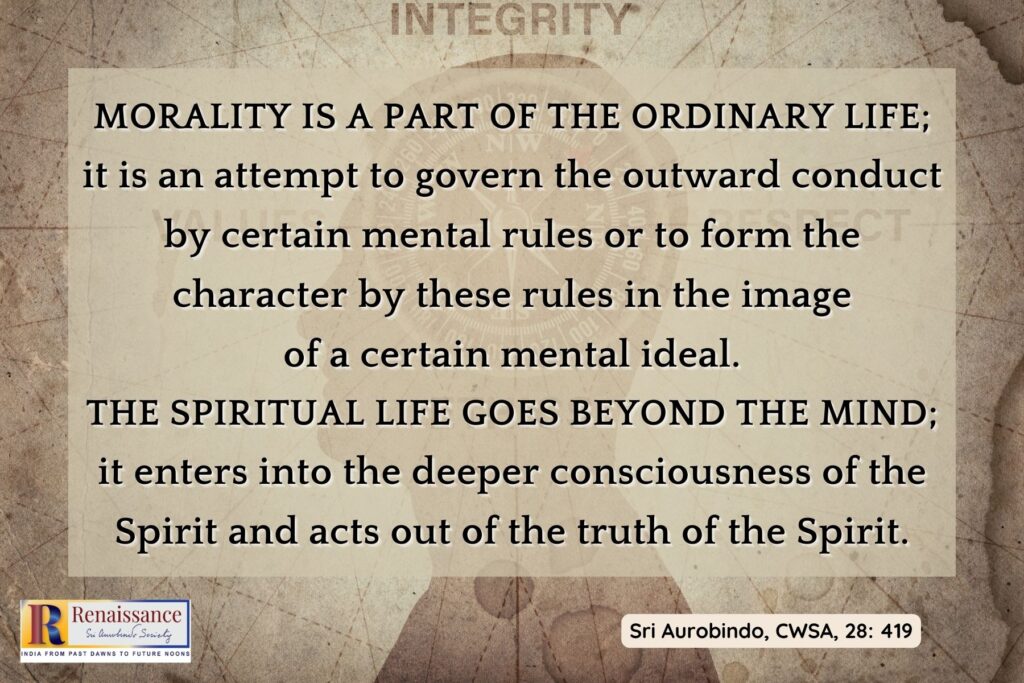
Spiritual Life Demands Complete Mastery over Vital Movements
In the ordinary life, people accept the vital movements, anger, desire, greed, sex etc. as natural, allowable and legitimate things, part of the human nature. Only so far as society discourages them or wishes to keep them within fixed limits or subject to a decent restraint or measure, people try to control them so as to conform to the social standard of morality or rule of conduct.
Here on the contrary as in all spiritual life, the conquest and complete mastery of these things is demanded. That is why the struggle is more felt, not because these things rise more strongly in sadhaks than in ordinary men, but because of the intensity of the struggle between the spiritual mind which demands control and the vital movements which rebel and wish to continue in the new as they did in the old life.
Does Sadhana raise up lower vital movements?
As for the idea that the sadhana raises up things of the kind, the only truth in that is this that, first, there are many things in the ordinary man of which he is not conscious because the vital hides them from the mind and gratifies them without the mind realising what is the force that is moving the action—thus things that are done under the plea of altruism, philanthropy, service etc. are largely moved by ego which hides itself behind these justifications; in Yoga the secret motive has to be pulled out from behind the veil, exposed and got rid of.
Secondly, some things are suppressed in the ordinary life and remain lying in the nature, suppressed but not eliminated; they may rise up any day or they may express themselves in nervous forms or other disorders of the mind or vital or body without it being evident what is their real cause. This has been recently discovered by European psychologists and much emphasised, even exaggerated in a new science called psycho analysis.
Here again in sadhana one has to become conscious of these suppressed impulses and eliminate them—this may be called raising up, but that does not mean that they have to be raised up into action but only raised up before the consciousness so as to be cleared out of the being.
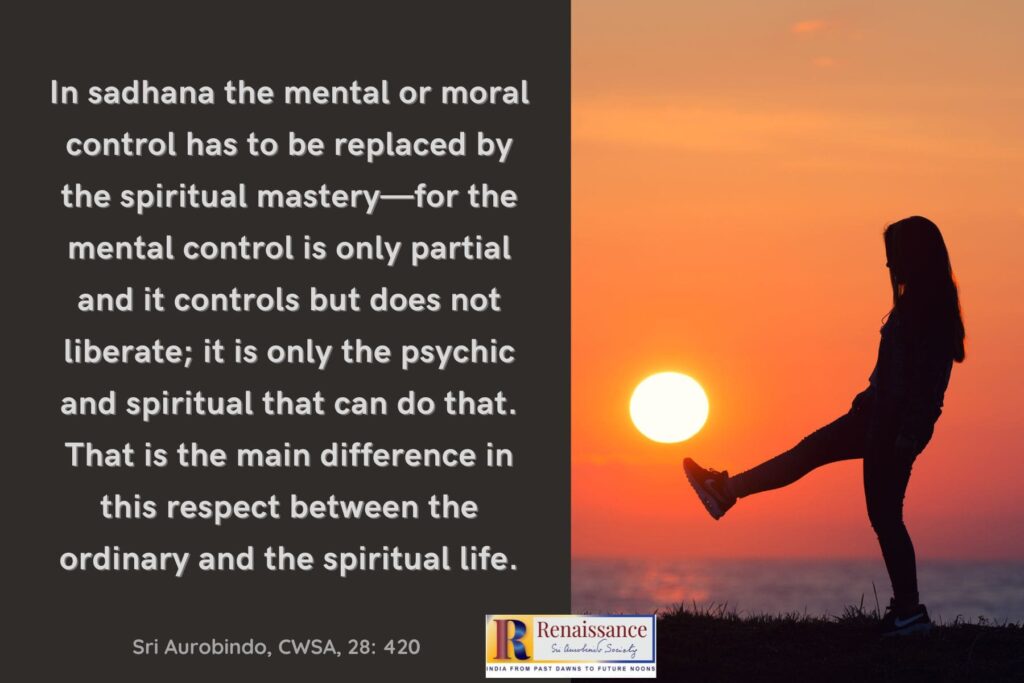
Difference of temperament
As for some men being able to control themselves and others being swept away, that is due to difference of temperament. Some men are sattwic and control comes easy to them, up to a certain point at least; others are more rajasic and find control difficult and often impossible.
Some have a strong mind and mental will and others are vital men in whom the vital passions are stronger or more on the surface. Some do not think control necessary and let themselves go.
In sadhana the mental or moral control has to be replaced by the spiritual mastery—for the mental control is only partial and it controls but does not liberate; it is only the psychic and spiritual that can do that. That is the main difference in this respect between the ordinary and the spiritual life.
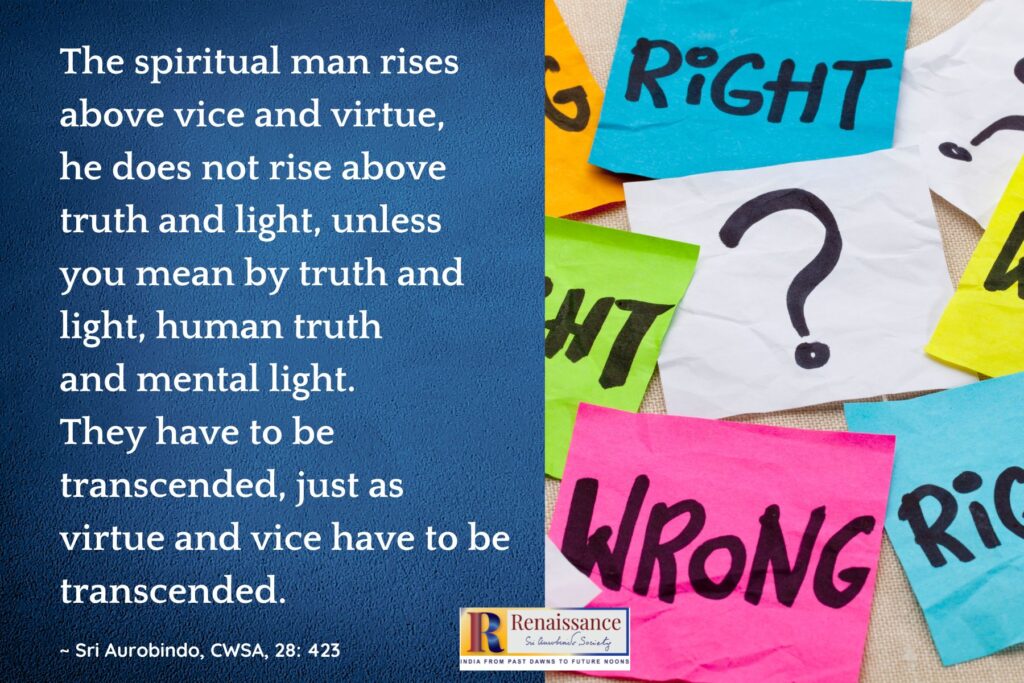
Ordinary Life as Field of Experience
Everything depends upon the aim you put before you. If for the realisation of one’s spiritual aim it is necessary to give up the ordinary life of the Ignorance (saṁsāra), it must be done; the claim of the ordinary life cannot stand against that of the spirit.
If a Yoga of works alone is chosen as the path, then one may remain in the saṁsāra, but it will be freely, as a field of action and not from any sense of obligation; for the Yogin must be free inwardly from all ties and attachments. On the other hand there is no necessity to live the family life—one can leave it and take any kind of works as a field of action.
In the Yoga practised here the aim is to rise to a higher consciousness and to live out of the higher consciousness alone, not with the ordinary motives. This means a change of life as well as a change of consciousness.
But all are not so circumstanced that they can cut loose from the ordinary life; they accept it therefore as a field of experience and self-training in the earlier stages of the sadhana. But they must take care to look at it as a field of experience only and to get free from the ordinary desires, attachments and ideas which usually go with it; otherwise it becomes a drag and hindrance on their sadhana. When one is not compelled by circumstances there is no necessity to continue the ordinary life.
One becomes tamasic by leaving the ordinary actions and life only if the vital is so accustomed to draw its motives of energy from the ordinary consciousness and its desires and activities that if it loses them, it loses all joy and charm and energy of existence. But if one has a spiritual aim and an inner life and the vital part accepts them, then it draws its energies from within and there is no danger of one’s being tamasic.
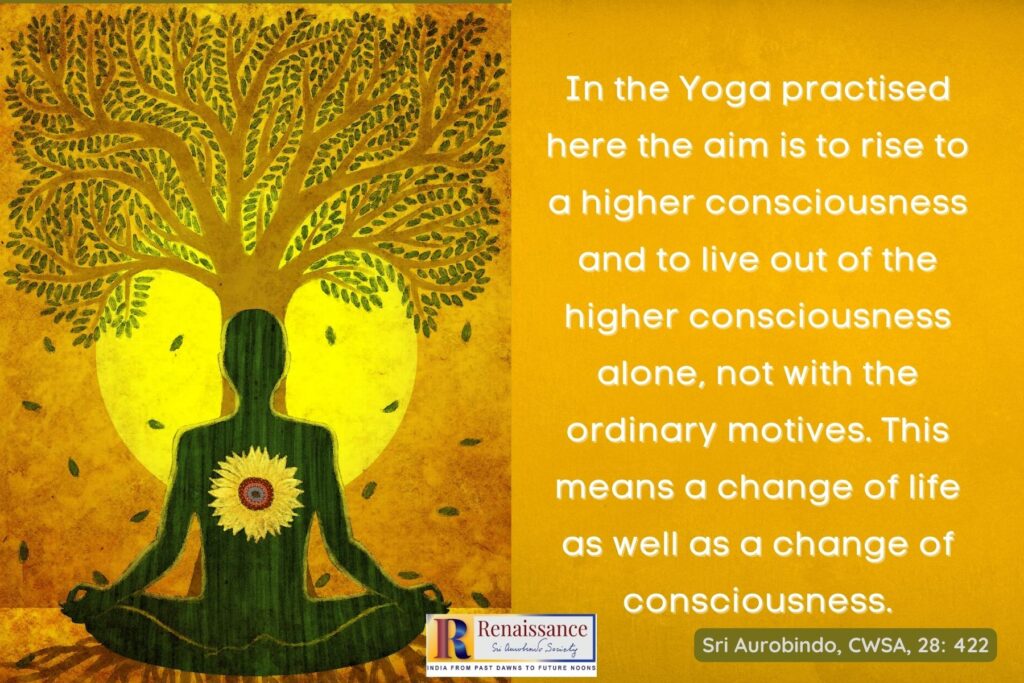
The Sattwic Man and the Spiritual Man
It is a very beautiful character that you describe in your letter, a perfect type of the sattwic man, a fine and harmonised ethical nature supported and vivified by a fine and developed psychic being.
But still, although it may be regarded as an excellent preparation for the spiritual life, it cannot by itself be called spirituality—unless indeed we reduce the meaning of the word to the connotation ordinarily given to it in the West where mental ideation, ethical striving, a flowering of fine character, altruism, self-sacrifice, self-denial, philanthropy, service to men or mankind are considered the height of spiritual aspiration or spiritual attainment.
Obviously if that is to be the last word of earthly achievement, there is no need for anything farther; the close and vivid discovery of soul or self, the straining towards that which is behind life and above mind, the passion for the Eternal or the Infinite, the hunger for a freedom and wideness of consciousness and existence not limited by the narrow moulds of intellect, character and the past life-aims of humanity, the thirst for union with the Divine or for the pure bliss and beauty of spiritual existence not tied down to mental and vital values must be dismissed as a superfluous dream for which there is neither place nor necessity here.
Yet these things have been not only dreamed of and hungered after but reached and tasted by beings born in a mortal and human body. Spirituality lies there; its essence consists in a bursting of the human mental, moral, aesthetic, vital moulds in order to reach beyond them and enter into a consciousness of which these things are the very stuff, to which these experiences are native.
Anything less than that, than a striving after it or at least a partial realisation of it is not spirituality. The spiritual man is one who has realised something of it even if only in one aspect out of many; one who is striving after it is the spiritual seeker.
All else however magnificently intellectual, ethical, aesthetically beautiful and harmonious, vitally splendid, great and forceful or physically perfect is a valuable achievement on the way, but not yet that, for one has not passed the Rubicon of mind into a new empire.
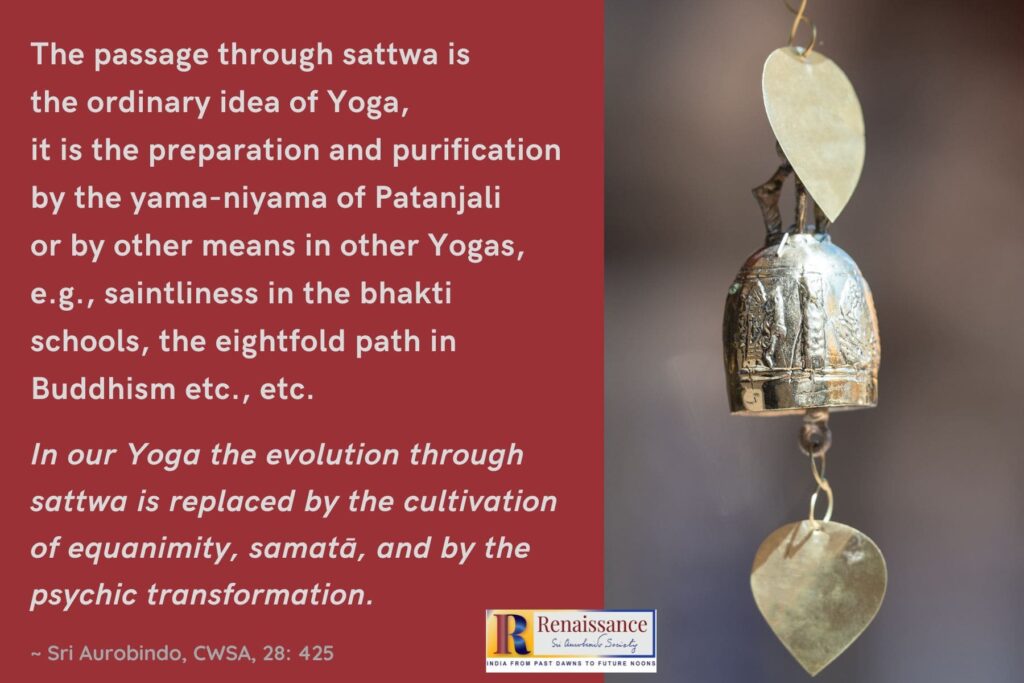
Confusion in Western ideal of spirituality
Owing to the nature of the past evolution of consciousness and of spirituality itself, there has been much confusion on this point and there is still more today because of the present domination of the Western ideal.
On one side or another mental idealism, ethical development, altruistic character and action, religious piety and fervour, occult powers, feats of ascetic endurance have been put forward as the essence of spirituality or the test or proof of achievement or the signposts of the journey to spiritual perfection.
It is ignored that any of these things may be there and yet there need not be any spiritual life behind it, any rebirth into a new consciousness or any remoulding of either the inner or the outer consciousness no longer in a higher or richer power of mind and life and body only, the instruments, but in the direct light and force of the hitherto veiled user of the instrument, the now revealed and directly active soul, self, spirit or of the Divine or Eternal whose representatives or aspects they are.
This confusion meets us at every point and in all sorts of forms whose common error is to ignore the essence and core of the matter.

The Western intellect presents us with the strivings of the mind, life, emotions, passions, moral will and tells us these are the real spiritual things, man’s highest aim and endeavour and all else is vain mysticism, asceticism, evasion of life. It appears that the lined and ravaged face of a Greek bust of Homer is a thousand times more spiritual than the empty calm or the ecstatic smile of the Buddha!
We are told by others that to care for the family and carry out our social and domestic duties, to be a good man, a perfect citizen, patriot, worker for the community, to serve mankind are the real things far more spiritual than to sit in idle meditation seeking for some remote and invisible transcendental Reality—or unreality.
Philanthropy, altruism, service, selfless labour for humankind, these are the spiritual summits. True selflessness lies there, to sacrifice or offer one’s life to the good of others, to the community, to the race. To seek one’s own inner spiritual growth, to draw back from ordinary life in order to reach something beyond, to search after the Divine above humanity is mere egoism, not true spirituality, but an aberration, a misdirection of the will and life.

All that might be admirable and true—as certainly all the things thus eulogised have their place in the human evolution, if the premiss on which it were founded were true—that the seeking for something behind, something beyond, something of which the evolution of mind, life and body was only a veil or a preparation is an illusion and a chimaera.
But if these things are real, if the seeking is a lasting and major drive in Nature, then all these objections and recommendations are futile. For this drive will fulfil itself, this hidden reality will draw and draw us till we achieve it. Those who feel its call, cannot do otherwise than follow and strive, even if need be leave all else for it, hold all other greatness, splendour, nobility, beauty as cheaper minor things compared with this other Light and Greatness and Beauty of which they have had the vision, the intimation, the formless attraction or else the passing touch or glimpse.
Ever since Mind itself reached a certain development, there has been at first dimly and gropingly, then more and more clearly and intimately this drive in man towards something behind and beyond Man, towards the discovery or the expression of something hidden in his being and a world existence which is more real than his surface self even at its best, greater, fuller, truer, more divine.
To arrive at that can come only by a change of consciousness, a reversal of consciousness, a new basis of consciousness which is not the lower instrumental consciousness of mind, life and body.
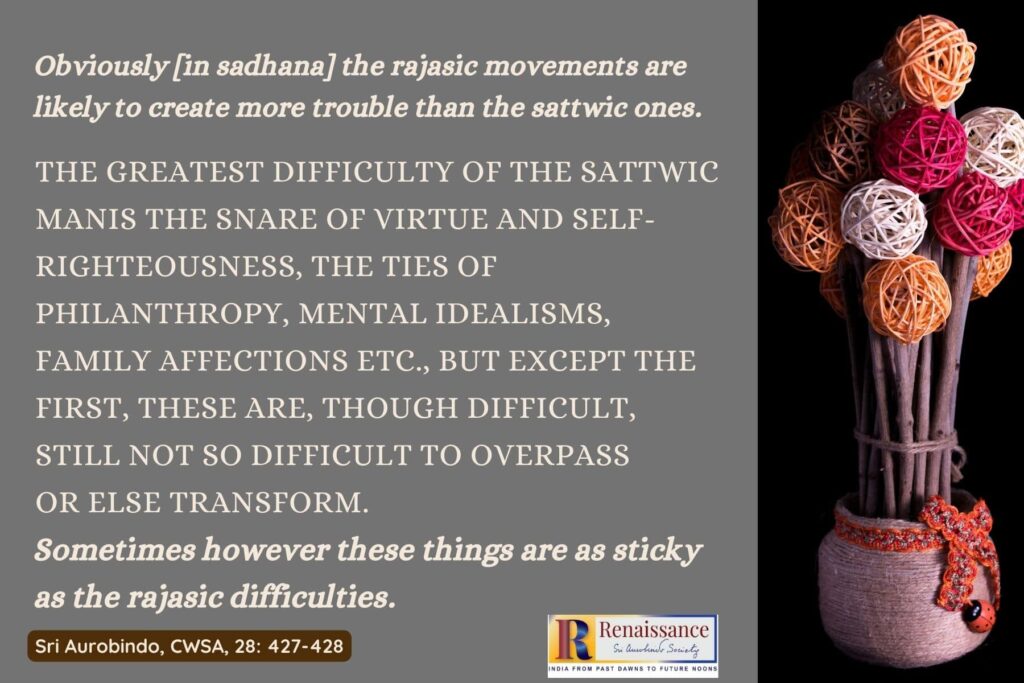
~ Sri Aurobindo, CWSA, Vol. 28, pp. 419-428

~ Design: Beloo Mehra

